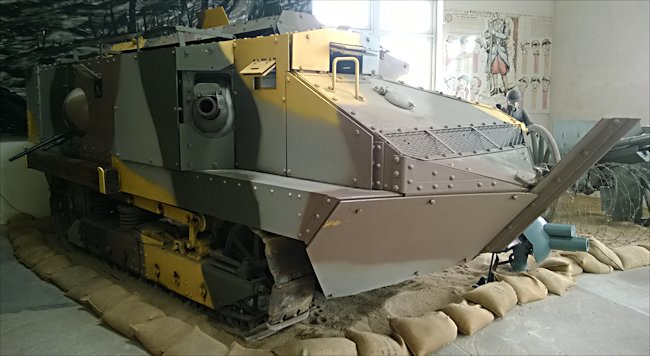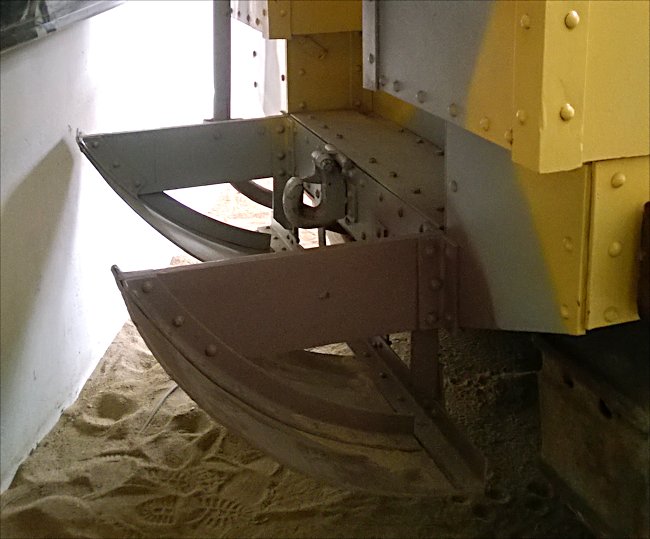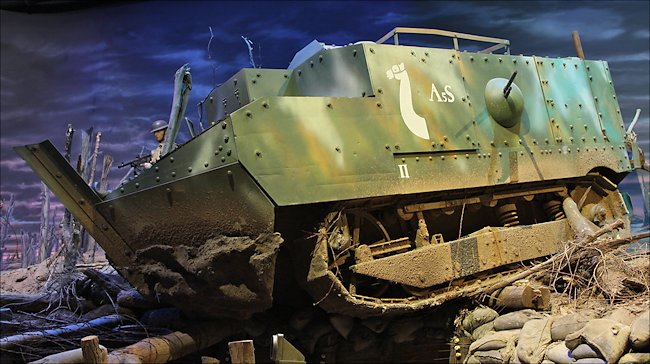Schneider CA1
This WW1 French Schneider CA 1 Char Tank can be found at the French Tank Museum in Saumur in the Loire Valley. The Museum is called Musée des Blindés ou Association des Amis du Musée des Blindés, 1043, route de Fontevraud, 49400 Saumur, France www.museedesblindes.fr . The word Blindés means armoured

WW1 French Schneider CA 1 Char Tank
This WW1 French Schneider CA Tank was shipped to America after the war on loan, for evaluation and testing. It ended up in the U.S. Army Ordnance Corps Museum, Aberdeen Proving Grounds in Maryland, USA. It was given back to the French Government, following a request for the return of their tanks, in 1985 along with a WW1 St-Chamond tank and a Renault FT tank. Its war record is not known.
The author Steven Zaloga visited the U.S. Army Ordnance Corps Museum, Aberdeen Proving Grounds museum before it closed. Each vehicle had a 'property jacket', a file that contained all the information and documnets relating to that specific vehicle. In the WW1 tank files there was nothing regarding their military history. The saddest collection of files were in a file drawer of "de-accessioned" (scrapped) vehicles that were sent to the Baltimore smelters over the years. This included a very rare German WW1 A7V heavy tank. What a waste.
The tank design
The Char Schneider CA 1 tank was built in 1916. It was designed as an assault vehicle to be used for launching attacks on German trenches. It was found to have poor trench crossing performance which led to disappointing results in combat. The Holt type tractor chassis and a boxy, rather unwieldy, superstructure proved inadequate for operational use. During the attack at berry au Bac on 16th April 1917 around 132 Schneider CA-1 tanks left the start line.
Only 56 survived. They were either destroyed by German Artillery or abandoned by their crew after being stuck trying to cross a trench or shell hole. mechanical break down was also a problem. The French word "Char" translated means tank.

The Schneider CA 1 Tank was armed with one 75 mm blockhaus Schneider cannon fixed to the front right-hand side of the vehicle
The French army reject the first Tank design
In 1903 the French army had a chance to become the first nation begin tank manufacturing. Before World War I French captain Levavasseur submitted a plan to create an armoured self-propelled gun. After five years of testing this project was eventually rejected.
At the start of World War I it soon became clear that some form of armoured warfare was needed. Trench warfare had led to stalemate. Advances were only taking a few kilometres at a time at the cost of huge casualty lists. Something was needed that could break through enemy fortified lines.
Assault infantry lacked the firepower to suppress machine gun posts and massed artillery. World powers began to work towards finding a solution for this type of warfare. The German army invested heavily in long ranged heavy artillery. The British and French tried to find ways of moving there field guns closer to the enemy.

The WW1 French Schneider CA 1 Tank was armed with two 8mm Hotchkiss M1914 machine guns
One senior member of the French army, who helped with designs, was Colonel Jean Baptiste Estienne. He would later received the nickname as "the Father of the tank". He was inspired by the testing of the American "Holt" agricultural tracked tractor to tow large field guns across rough countryside. He believed that victory in the war would belong to the belligerent, which is the first to put cannon on a vehicle capable of moving over all kinds of terrain.
After much perseverance Estienne was able to enlist the support of General Joseph Joffre to start a tank development project. In early February of 1916 the first French prototypes known as "Schneider" were ready for testing. It was placed in friendly competition the larger "Saint Chamond" French tank design.
Using the example of the British, these top-secret military projects were dubbed agricultural tractors. These new French tanks continue to suffer from poor aiming angles. They had difficulties getting their guns to register on enemy targets. They also had problems successfully crossing trenches.

An agricultural catapilar track system based on the American Holt company's design was used on the French Schneider CA 1 Char Tank
The French Schneider CA 1 Char Tank was very similar in shape to the first British tank called little Willie. They were both of the box shape of stuck onto the top of standard caterpillar tracks. During test the British had found the limitations of the design and gone for the radical trapezoid wraparound track shaped design that will become the British Mark 1 tank.
The French design lacked a turret. It was armed with one 75 mm Blockhaus Schneider cannon fixed to the front right-hand side of the vehicle. It had two additional weapons. These were 8mm Hotchkiss M1914 machine guns.
The tank was designed by the Schneider company. This is how it got its name. The tank was manufactured near Paris at its subsidiary company SOMUA. Around 400 Schneider CA 16 Chars were built. It weighed 13.6 tonnes and was 6.32 m long (20ft 9 inches). It needed a crew of 6; the commander, driver, engineer and gunners.

To assist in crossing trenches a skid was placed at the front of the French Schneider CA 16 Char Tank
The Schneider CA 1 Char Tank was first used in combat on 16 April 1917. It was a failure. It had problems crossing the deep crater strewn landscape of no man's land and widened German trenches. Some suffered mechanical breakdowns. The Schneider CA 16 Char Tanks that became immobilised had to be abandoned quickly by the crew as they soon became targets for enemy artillery.
The 75 mm blockhaus Schneider cannon was not intended to take on other tanks. This scenario was not foreseen at this stage of tank development. Cannon fired high explosive rounds short ranges. It was designed to deal with enemy strong points and machine gun posts. It fired the standard French artillery HE model 1915 75mm shell.
The two 8mm Hotchkiss M1914 machine guns were not placed to the front of the Schneider CA 1 Char Tank like in modern tanks. They were designed to be used to rake German troops to the left and to the right of the vehicle as it crossed over the top of the trench.
The front of the Schneider CA 1 came to a point. Attached to the underside of the front armour was a vertical skid. Along metal arm the extended away from the body at an angle. This was designed to crush and cut through German barbed wire so the following infantry could advance with the tank and capture enemy trenches. It also helped in negotiating the far side of muddy German trenches and stopped the pointed nose getting impaled in the mud.

To help it travers German trenches the rear of the French Schneider CA 1 Char Tank was fitted with two metal skid blades.
The 100 year Aniversary Restoration
The French Tank Museum took both the WW1 Schneider CA tank and the Saint-Chamond tank off public display in 2016 and financed a major restoration project. They had mecanical overhauls as well as a more acurate camoflauge livery.Where else can I see a Schneider CA 1 Tank?
The Schneider CA 1 tank in France is the only surviving example. There is a wooden reproduction of a Char Schneider CA1 tank inside the 1st Infantry Division museum in Cantigny Park, IL, USA near Chicago. It is placed in a realistic diorama of the the tank crossing no-mans-land and the first line of German trenches. I like the application of mud to the front of the replica to give it a more realistic look.

Replica Char Schneider CA1 tank inside the 1st Infantry Division museum in Cantigny Park, IL, USA
French tank books

